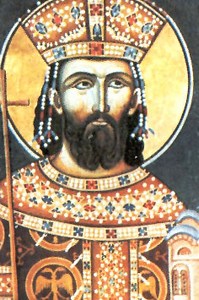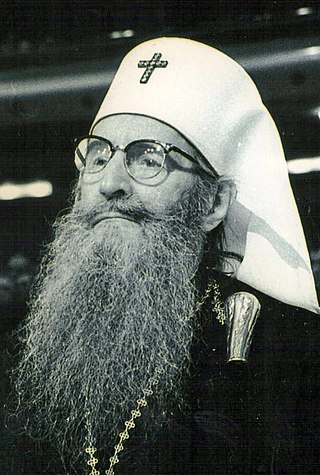
Lazar Hrebeljanović was a medieval Serbian ruler who created the largest and most powerful state on the territory of the disintegrated Serbian Empire. Lazar's state, referred to by historians as Moravian Serbia, comprised the basins of the Great Morava, West Morava, and South Morava rivers. Lazar ruled Moravian Serbia from 1373 until his death in 1389. He sought to resurrect the Serbian Empire and place himself at its helm, claiming to be the direct successor of the Nemanjić dynasty, which went extinct in 1371 after ruling over Serbia for two centuries. Lazar's programme had the full support of the Serbian Orthodox Church, but the Serbian nobility did not recognize him as their supreme ruler. He is often referred to as Tsar Lazar Hrebeljanović ; however, he only held the title of prince.

Josif Rajačić, also known as Josif Rajačić-Brinski, was a metropolitan of Sremski Karlovci, Serbian Patriarch, administrator of Vojvodina, and baron.

The Serbs of Vojvodina are the largest ethnic group in this northern province of Serbia. For centuries, Vojvodina was ruled by several European powers, but Vojvodina Serbs never assimilated into cultures of those countries. Thus, they have consistently been a recognized indigenous ethnic minority with its own culture, language and religion. According to the 2022 census, there were 1,190,785 Serbs in Vojvodina or 68.43% of the population of the province.

German was the 43rd Patriarch of the Serbian Orthodox Church from 1958 to 1990. He was successful in revitalizing the Serbian Orthodox Church to a certain extent during the Communist period, despite two schisms that occurred during his tenure.

The Eparchy of Srem is an eparchy (diocese) of the Serbian Orthodox Church in the Syrmia (Srem) region, Serbia. Most of the eparchy is in the autonomous province of Vojvodina, and it also includes a small south-eastern part of Syrmia within the city limits of Belgrade, as well as some West Syrmian parishes in the border region of Croatia. The seat of the eparchy is at Sremski Karlovci. Since 1986, the diocesan bishop is Vasilije Vadić.

The Eparchy of Banat is an ecclesiastical territory or eparchy of the Serbian Orthodox Church in the Banat region, Serbia. It is mostly situated in the autonomous province of Vojvodina, while the eparchy also includes a small south-western part of Banat that belongs to the City of Belgrade as well as village of Ostrovo that belongs to the city of Požarevac. The seat of the eparchy is in Vršac.

The Metropolitanate of Karlovci was a metropolitanate of the Eastern Orthodox Church that existed in the Habsburg monarchy between 1708 and 1848. Between 1708 and 1713, it was known as the Metropolitanate of Krušedol, and between 1713 and 1848, as the Metropolitanate of Karlovci. In 1848, it was elevated to the Patriarchate of Karlovci, which existed until 1920, when it was merged with the Metropolitanate of Belgrade and other Eastern Orthodox jurisdictions in the newly established Kingdom of Serbs, Croats and Slovenes to form the Serbian Orthodox Church.

The Patriarchate of Karlovci or Serbian Patriarchate of Sremski Karlovci, was a patriarchate of the Eastern Orthodox Church that existed between 1848 and 1920. It was formed when the Metropolitanate of Karlovci was elevated to the rank of patriarchate. The Patriarchate of Karlovci nominally existed until 1920, when along with several other Eastern Orthodox jurisdictions in the defunct Austro-Hungarian Empire, as well as the Metropolitanate of Cetinje, it was merged with the Metropolitanate of Belgrade to form the united Serbian Orthodox Church. The seat of the Patriarchate was in Karlovci.

Vikentije (II) was the fourth partriach of the reunified Serbian Orthodox Church, from 1950 until his death.

The Patriarchate Court is a listed historical building which was the seat of the Patriarchate of Karlovci between 1848 and 1920, in Sremski Karlovci, Serbia.

Nikanor Grujić was the Serbian Orthodox bishop of Pakrac, the locum tenens Serbian Patriarch, the Austro–Hungarian emperor's Privy Councilor, knight of the Grand Cross of the Franz Joseph order, member of Houses of Magnates at Hungarian and Croatian–Slavonian parliaments, member of Serbian Learned Society, writer, poet, orator and translator.

The Metropolitanate of Zagreb and Ljubljana is an Eastern Orthodox eparchy (diocese) and one of the five honorary metropolitanates of the Serbian Orthodox Church. The headquarters of the metropolia is located in Zagreb, Croatia, and its jurisdiction covers northern Croatia and the entire territory of Slovenia.

Archbishopric of Belgrade and Karlovci is the central or patriarchal eparchy of the Serbian Orthodox Church, with seat in Belgrade, Serbia. The head of the eparchy is the Serbian patriarch.

Serbian Orthodox Eparchy of Slavonia is an eparchy (diocese) of the Serbian Orthodox Church encompassing areas of western and central Slavonia, Croatia. Since 2014, the Eparchy is headed by bishop Jovan Ćulibrk.

The Eparchy of Buda is a diocese or eparchy of the Serbian Orthodox Church, having jurisdiction over the territory of Hungary. The seat of the eparchy is in Szentendre near Budapest.
The Eparchy of Mukachevo and Prešov was an Eastern Orthodox diocese (eparchy) of the Serbian Orthodox Church, that existed from 1931 to 1945. It had jurisdiction over regions of Slovakia and Subcarpathian Rusynia, at that time parts of former Czechoslovakia. Its seat was in Mukachevo.
Evgenije Letica was a Serbian theologian, Metropolitan of the Eparchy of Banja Luka (1900–1907) and Metropolitan of Dabar-Bosna (1907–1920).

Miron Nikolić was bishop of the Patriarchate of Karlovci and, after 1920, of the united Serbian Orthodox Church.
Gavrilo Zmejanović was a bishop of the Serbian Orthodox Church and an unconfirmed Serbian Patriarch.

Georgije Letić was the bishop of the Serbian Orthodox Church in what is today Romania. He was a progressive educator who promoted co-education.

















